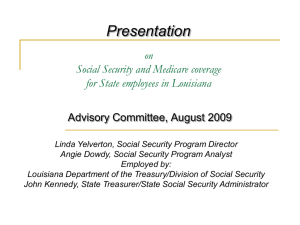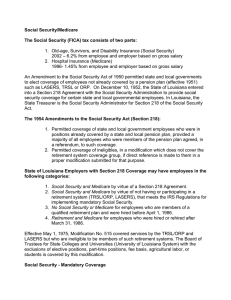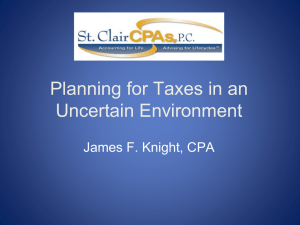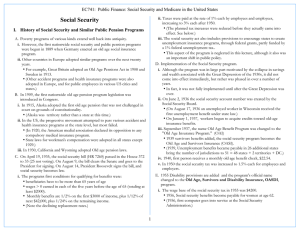Fin 360: Employee Benefits
advertisement
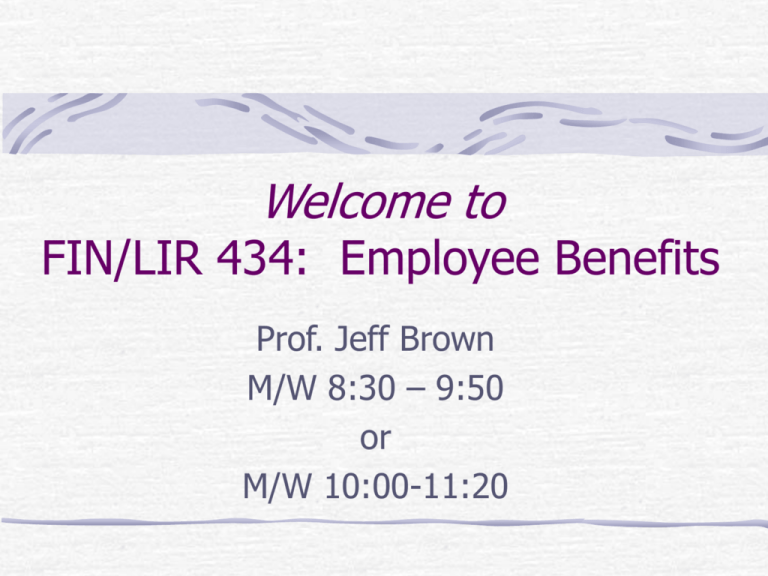
Welcome to FIN/LIR 434: Employee Benefits Prof. Jeff Brown M/W 8:30 – 9:50 or M/W 10:00-11:20 Examples of Employee Benefits? 5 Traditional Categories 1. Legally required social insurance 2. Payments for private insurance and retirement plans 3. Payments for time not worked 4. Extra cash payments to employees 5. Cost of services to employees A Sampling of Course Topics Retirement Income Pension plans – DB and DC Social Security Health Insurance Medicare Employer Provided Health Care Incentive Based Compensation Stock Options Three Perspectives of the Course 1. As an employee, how can you best utilize the benefits that you are offered? 2. As an employer, how do you make effective use of employee benefits to maximize the value of your firm? 3. As a concerned citizen or policy-maker, what is the appropriate role for the government in regulating / providing benefits? Is this Course Relevant? In 2004, for every dollar paid in wages, employers spent another 40 cents on benefits Employee benefits are a major force in determining employee retention / happiness Government provided benefits (e.g., Social Security and Medicare) are by far the largest expenditure of the federal budget Government tax subsidies for privately provided benefits amount to hundreds of billions of dollars It is in the news nearly every day The Syllabus It is a “contract” – read it carefully! At some point in this course, I may ask a question on an in-class exercise or exam about the syllabus – so read it! www.business.uiuc.edu/jbrown/fin434.htm Check it out early and often, as it will contain: Class announcements Lecture notes in Power Point Problem sets Solutions Group projects Handouts Because of this web site, this largely will be a “paper-less” classroom Getting to Know You Please Tell us the Following Information: Your name Your year and major What you want out of this class Something interesting about yourself that will help us remember you Is this guy qualified to teach me? Education B.A., Miami University (Ohio) M.P.P., Harvard University Ph.D. (Economics), MIT Academic Experience At UIUC since June 2002 (formerly professor at Harvard) Research is focused on Social Security, pensions, annuities, life insurance and long-term care insurance “Real World” Work Experience Brand Management, Procter & Gamble Co. White House Council of Economic Advisers President’s Commission to Strengthen Social Security Consultant to White House, Treasury, GAO, World Bank, several private firms, and political candidates Introduction to Employee Benefits By the end of this (brief) lecture, you should be able to: Give a very brief and incomplete history of how employee benefits have developed in US Name the three most important factors influencing employee benefits Explain the significance of employee benefits to companies, individuals and the economy U.S. Benefits “History” 1636: Plymouth settlers’ military pension 1797: Gallatin Glasswork’s profit sharing plan 1875: American Express – first US private employer pension 1902: First workers’ comp law 1911: First group life plan 1935: Social Security Act 1966: Medicare & Medicaid 1974: ERISA 2003: Rx Drugs Added to Medicare Program 2006: Pension Protection Act What are Employee Benefits? The Broad View “All benefits and services, other than direct wages, provided to employees” Insurance against accident, illness, disability, unemployment, death Retirement savings and income Vacations and holidays Tuition assistance, fitness centers, even massages! Three Most Important Factors Influencing Employee Benefits 1. Self-Interest of Decision Makers 2. Taxation 3. Demographics Self-Interest of Decision Makers What are each of these groups after? Shareholders Company Executives Employees Unions Congress and other Policy Makers Taxation Tax laws determine which benefits receive favorable tax treatment, and which do not. Congress has decided to provide favorable tax treatment to: Pensions, health insurance, dental work, & more Taxes can influence: Whether to offer a particular benefit The form that benefit will take Changing Demographics Gender and the workplace Longevity Age Distribution Parenting Roles Household Composition How Costly Are Benefits? In 2004, for every dollar paid in wages and salaries to civilian workers in the U.S., employers spent another 40 cents on benefits Source: EBRI databook on Employee Benefits Chapter 3 If add in employee payroll deductions, total expenditures on benefits exceed 50 cents per dollar spent on wages and salaries Ballpark – the U.S. spends $1.5-$2 trillion dollars per year on benefits (roughly equal to GDP of U.K. or Germany) Total Compensation Costs (Civilian Workers 2004) Component Cost per Hour worked Percent of Total % Increase since 1995 $24.95 $17.71 $1.66 100% 71% 7% +36% +35% +36% Suppl. Pay (shift pay, bonuses) $0.60 2% +70% Insurance (life, health, disability) $1.93 8% +67% Pensions $0.99 $2.01 4% 8% +39% +26% Total Wages / Salaries Paid leave (vacations, sick) Legally required (SS, Medicare, Unempl., WC) A Sampling of Current Issues Reform of the PBGC “Automatic enrollment” in 401(k) plans Social Security reform Company stock in 401(k) plans Mismanagement of 401(k) plan assets Accounting treatment for stock options Age discrimination in conversion to cash balance plans Tax reform commission – treatment of fringe benefits Current Issues, continued Rising health care costs The uninsured Same sex domestic partner benefits DNA testing Medicare Rx drug coverage Importing Rx drugs from Canada Mental health parity Rx coverage of birth control devices Long-Term Care Insurance WSJ: Ten Ways Employers Benefit from Benefits Plans 1. 2. 3. 4. 5. 6. 7. 8. 9. 10. Pension piggy banks Inducements for downsizing Low cost retiree health coverage Savings from Medicare Cheaper than salaries Benefit plans as profit centers Payroll savings from pretax plans Low cost loans Joys of 401(k)s for employers Deducting dividends


